COVID-19 Response Minister, Chris Hipkins, volunteered fodder for jokes yesterday, when he stumbled on an unfortunate combination of “spread their wings” and “stretch their legs.”
Advice from @chrishipkins for those who want to "get out and spread their legs" pic.twitter.com/xIt8YUTy2J
— Dan News (@dannews) August 22, 2021
Chuckles aside, what was no laughing matter was his perverse transport advice:
It is a challenge in higher density areas for people to get outside and to
spreadstretch their legs when they are surrounded by other people, and so in some cases it might be more sensible for them to drive a short distance to get to somewhere where they can be further from other people.
People need to be able to walk and bike around with plenty of road space for social distancing – without fear of being hit by vehicles. The last thing that those living in higher density areas need is any messaging from the Minister that increases vehicle travel in their neighbourhoods!
While I’m sure the Minister didn’t intend to worsen the safety environment for people out getting their vital exercise, the comment was far from aligned with the Government’s key strategic transport priorities. A truly robust public health response requires focusing on the needs of people travelling actively, and involves widespread road reallocation – in both urban and suburban areas. There are major public health and environmental implications of the Government’s failure to tackle this last year (which we’ll post about soon).
It is worrying that the problems seem to stem from the Minister being stuck in a car dependent mindset.
Minister Hipkins is also the Minister of Education.
Is it Minister Hipkins’ mindset that is preventing school transport policy from improving, too? The Ministry could make key changes in:
- Design of School Buildings, Grounds and Amenities,
- Advocacy and Education
- Travel planning for staff and students
Around the world, cities have made schools a key part of their decarbonisation and climate adaptation plans.
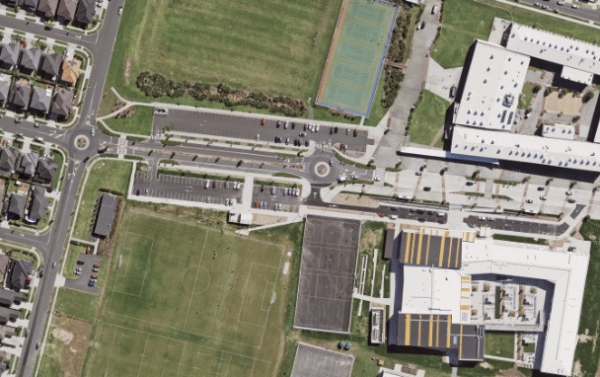
I have written on this topic before, showing the many ways the Ministry of Education could help to enable children to travel actively, improving their health and opportunities to learn, and setting them up for life-long healthy travel habits. I’ve explained that the Ministry of Education has:
- No policies for reducing transport carbon emissions in ways the Ministry can influence, such as good school property design and guidelines for day-to-day operations
- No policy about encouraging students and staff to shift away from car travel towards healthier low-carbon options,
- Received no instructions to prioritise walking and cycling in the design of its properties,
- Received no instructions to reduce transport carbon emissions.
Why? And why did the Government (which claims to be focused on climate action, children’s wellbeing, and road safety) not use the Education and Training Act 2020 to help address these issues?
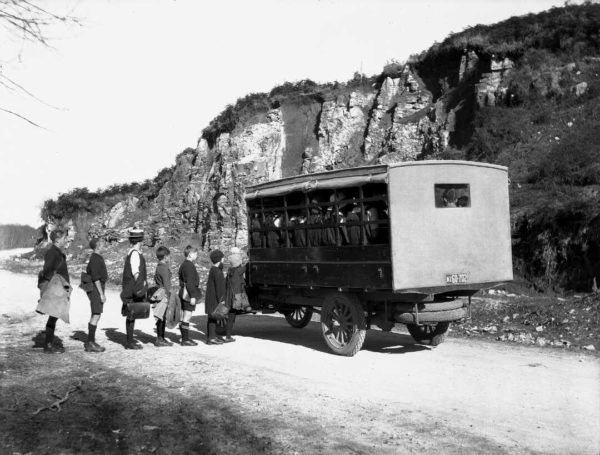
No Mandate for Change
Last year, a petition was presented to parliament about the problem of insufficient school bus services for rural areas. School buses are generally only provided for children living beyond a “walkable distance” of 5 km from school (or from any available public transport to school). For children under 10, this distance is 3 km. The trouble is, these roads aren’t safe, and shouldn’t be considered “walkable”. The rule originated in the very early 1900’s, when roads were safe enough for children to walk, bike or ride horses. As motor vehicle traffic increased in volume and speed, the country’s options were to:
- improve the roads with parallel safe networks for walking and riding,
- increase our provision of public and school transport services to ensure no one had to walk or ride on the open road, or
- a combination of these in different places, depending on population density.
Instead, our roads became dangerous for anyone not in a motor vehicle, and rural children were stripped of all safe independent travel options.
Today, the anachronistic rule about eligibility for school transport reduces the direct cost to taxpayers, but adds overall costs to the nation, because many parents have to fill the gap by driving children to school in many cars. One bus picking up multiple students and driven by one driver would be more efficient in terms of human and transport resource. The situation also:
- increases emissions,
- increases traffic danger for children who are walking or cycling in the “town” areas closest to the school, and
- eliminates independent mobility for the children, with many negative effects, including unhealthy reliance on parents’ time and current driving license status.
With population growth in some areas, demand for the school buses has risen, meaning children have had to give up the seats they were filling to others living further out.
In a NZ Herald article in February, a Ministry official was quoted as saying:
There is no current mandate to change the school transport policy
Well that piqued my interest!
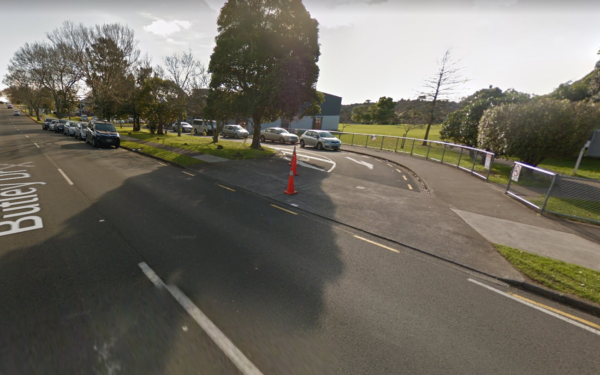
I asked the Ministry:
There are many ways this mandate could be found to already exist if the Ministry cares to look. For example, our Road to Zero policy, our Zero Carbon Act, and international obligations such as the 2020 Stockholm Declaration are obviously material to the decision about whether children have a right to a school bus if their only options are to walk along an egregiously unsafe road or to create unnecessary carbon emissions by being driven.
There will be human rights and equity laws, too…
Could you please provide me with all correspondence from the Ministry of Education to government:
- requesting direct instruction to the Ministry to reduce transport emissions
- requesting direct instruction to the Ministry to provide school buses for any child who has to walk along a rural road that lacks safe walking infrastructure
- requesting direct instruction to the Ministry to ensure every child has a safe journey to school.
The Ministry needs to reconsider if they really need an overt mandate from government before they can act responsibly on providing better transport options for children. But if they decide they do, it’s important they ask for such a mandate.

On the 31st March I received a reply
Advice tendered to Ministers can be in response to a request from the responsible Minister, or alternatively, it can be initiated directly by Government departments themselves. The Ministry of Education has not initiated advice which has sought a direct instruction from the Government on any of the three areas of your request.
The Age of School Buses
The Ministry proactively provided me with a briefing to Ministers Chris Hipkins and Jenny Salesa in September 2019, about the school bus tender process.
The document shows the Ministry had recommended – as a proxy for bus emissions standards – that operators should be required to use slightly younger buses, with a maximum bus age of 23 – instead of 26 as is currently the case – and that a maximum average bus age of 15 years in each operator’s fleet be introduced:

The requirement would have added 15% to the school bus tenders:

But the Ministers had declined the request:

As a result, the mandatory bus age requirements couldn’t be used:
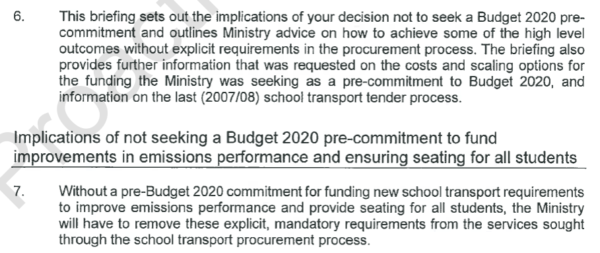
(The briefing covers other aspects, too, such as the difficulties created for the bus operators and the Ministry when the message from Government changes mid-process.)
In other words, the Minister’s lack of support meant the latest set of school transport contracts could not encourage operators to replace their oldest buses. This is hardly ideal from a safety OR carbon-reduction perspective.

Sustainable Travel to School
I wondered if Ministry staff were trying to achieve more profound systems changes regarding travel to school and if so, if the Minister had responded in a more satisfactory way?
Dear Ministry of Education,
Thank you for that example. What I am trying to understand is whether the Ministry has communicated concerns to the Minister on how current MoE policy contributes to current negative transport outcomes. Policy on transport, staff benefits, modeshift, school design, systems, school buses, operations and land use could be altered to improve outcomes in traffic safety, physical activity levels, mental health and carbon emissions…
Please provide me with any advice the Ministry of Education has given the Minister about policy or the need for policy on the following subjects:
- reducing transport emissions from journeys to school in the wider transport system (ie the travel by students, families, teachers and staff, not just school buses or Ministry fleet vehicles);
- better school design to create modeshift for students and staff from driving to active or public transport;
- reducing staff car parking provision in order to reduce driving;
- providing staff subsidies to bikes, e-bikes or bus fares to enable modeshift;
- improving safety for children and staff whose access to school is via a rural road that lacks safe walking and cycling infrastructure
- improving safety for children and staff whose access to school is on urban streets that are insufficiently safe for parents to allow their children to walk or cycle to school;
- improving traffic safety for children in the transport system and in and around schools, via changes in land use, school design, school systems, operations, advocacy to road controlling authorities;
- improving students’ mental health with MoE transport policy changes…

I later clarified:
I’m wanting to understand whether the Ministry of Education is
- already doing a body of policy work on this topic
- recommending changes but meeting resistance from other parts of government
- doing little to seek improvements / comfortable with the status quo…
I would appreciate any advice on modifying the request to reduce the Ministry workload or to better capture the information I’m after.
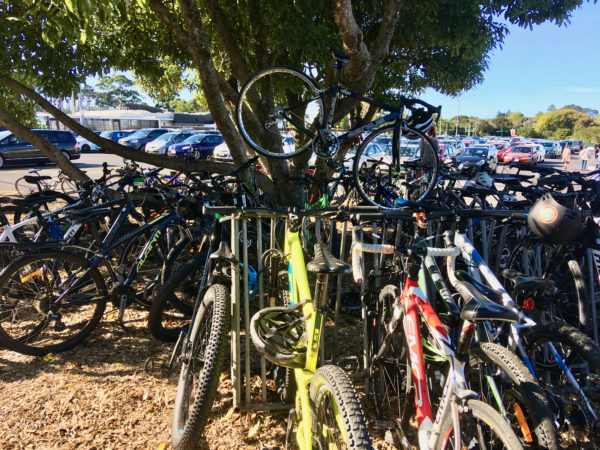
I received this reply on the 24th May, which was copied to the Minister of Education Chris Hipkins.
In short, my question was not answered. The reply includes a paragraph about the school bus procurement issue, although more detail had already been given in the briefing I linked above. The bulk of the reply is a long section about the climate change curriculum in schools, which was not something I asked about. And finally:
With regard to your questions regarding public health, these should be directed to the Ministry of Health as they are best placed to respond. You can contact the Ministry of Health at info@health.govt.nz
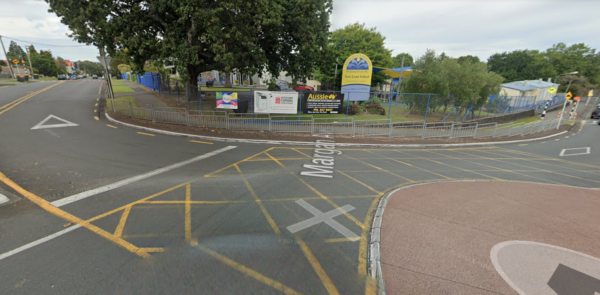
In summary
- The Minister of Education declined to approve the pre-Budget commitment which would have led to a requirement for younger school buses.
- Nobody seems to be addressing the problem of insufficient school buses on higher demand rural routes where the population has increased, and where no distance can be considered “walkable” due to traffic danger.
- The Ministry of Education did not answer my Official Information Act question, but it’s probably safe to assume:
- The Ministry of Education has not advised the Minister why transport policy matters, in terms of either student wellbeing and learning outcomes, or wider public health and environmental outcomes. Nor does it appear the Minister has given any direction on the topic.
The children of Aotearoa have been demanding the Government act on climate change. One major change they need is in our transport system, on a grand scale. The Ministry of Education can be a major player, stepping up to fill a guiding role on reducing transport emissions involved with ‘travel to education’ – in the same way they have stepped up to relieve unpaid school board trustees from carbon-counting obligations. Using good property design, staff contracts, transport policy, travel planning and parking management, the Ministry would be contributing to a climate action which would directly benefit and empower our children right now.
Minister Hipkins, we need you to sort this out:
Expand your thinking, and take responsibility for helping our children gain the option to travel – independently, sustainably and safety.
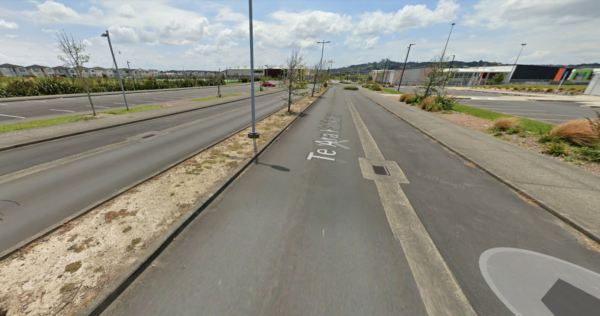

 Processing...
Processing...
Maybe he should have also pointed out that one reason it’s more difficult is that we have Auckland Transport and Auckland Council actually removing all of the road widening safety works on Queen Street–in the middle of an ongoing pandemic–that enabled people in the centre of the city to actually have some more space for physical distancing. The blinkered obsession with blocking any progress on Queen Street and actively maintaining vehicle dominance by both Auckland Transport and Auckland Council is frankly appalling.
Some school buses used for school trips in Auckland are so old they fill up with diesel fumes and give some kids headaches or motion sickness. So it’s not just emissions, and safety.
Epic post Heidi. Sadly this isn’t the only place the Ministry of Education
takes a head in the sand approach, with a failure to plan for population growth evident across the country.
I teach at one of the schools you have pictured there and am considered quite odd for cycling to school – despite there being protected paths on the way to it.
Which will give away where it is as there are far too few schools with a protected route.
It’s really frustrating talking with teachers who live the closest to their school and who drive. They really don’t understand how their vehicle movements increase danger to their own students.
But this comes down to having a Ministry framework within which infrastructure, incentives and disincentives combine to encourage people to make good choices. As Stephen Fry says:
“Understanding the common purpose for the common good – is that too much to ask?” https://twitter.com/XRebellionUK/status/1428628431047122945?s=19
The purpose of the Ministry of Education’s school transport policy (written in 1914 I think, and only updated to change miles into km) is to give free transport to country kids regardless of how far that is while making it impossible for kids who live in a town or near a town. The Ministry once told me some kids could walk 4km and cross the highway at the top of the Albany hill because some public buses went past there. I asked if they seriously thought a child, or anyone for that matter, should cross the high speed road there and the dude said “hell no, but that is the policy and they don’t qualify for a school bus”.
Yeah, and the country has plenty of rules like this that don’t work. One part of the job of any Ministry is to raise the problem of such anachronistic rules with the Minister to get them changed.
We seem to have a culture in which clearing out unhelpful rules isn’t supported, so bureaucracy becomes layers of stupidity. That needs to change. We need to become more nimble.
This needs to be led by Cabinet, who should be welcoming advice about how to streamline needed change.
I do see schools putting up extra classrooms on their green areas,rather than their asphalt, probably citing lack of space for expansion. Whenever l go past the Mt Roskill schools, it is a sea of car parks, there have been changes outside the boundaries,planter boxes instead of carparks, and raised pedestrian crossings, so some kudos there.
Repurposing staff carparks, whether for business or govt, (schools /hospitals), will be
seen as another “attack ” on ordinary people being unable to carry on BAU, ( l need my car as I am time poor,drop dependants at childcare,etc ). One of the LTN complaints was “having to pay extra for childcare as extra time was needed, after being “stuck in traffic”.
Any changes in current thinking,will always get pushback,and Hipkins defaulted to what he thought was an easy solution, to what he thought was a minor issue, l guess the climate change hat ,has been lost at the bottom of the wardrobe, right now.
The carparks and drop-off areas within the boundaries are paid for by the Ministry but it is AT who requires them. The Ministry would rather spend their money on buildings and learning materials.
If the Ministry would rather not include carparks and drop-off areas then they should be giving advice to the Minister about the need for him to sort it out with local government so they don’t have to. But it seems they haven’t raised it.
Have recently had my kid start school and it’s pretty appalling watching the traffic movements each day.
I drop her up on the cargo bike but it’s not what you’d call ‘safe’ (I’m just bullish about taking a lane)
Every morning I watch the school principal managing the drop and go area, and I think, ‘ok, he’s building relationships with the kids and being visible to the parents, but is this really the best use of his time?’
If Minister Hipkins is washing his hands of any responsibility for transport safety and decarbonisation within the Education and Covid Response portfolios, the quid pro quo would be that he supports every safety and transport decarbonisation decision that the Minister of Transport presents to Cabinet. Does he?
Enough members of Cabinet clearly don’t.
My primary school at some point created a pick-up and drop-off zone 200m from the school so at least kids coming in on foot or bicycle didn’t have to deal with all the nuisance.
That’s great. And this is an evidence-based approach; the further you can get the pick up / drop off area away from the school, the better the outcomes. Who initiated it, Roeland?
I would guess the school, I don’t know for sure. Or how they organised it, somehow the kids have to get to that pick-up spot in the afternoon. It has been a while so I don’t know how they do it right now.
I’ve read another school is not allowing pick-ups within a certain time after bell time. The news article says it is to disincentivise driving, but the more obvious benefit is that it allows others to leave before chaos ensues.
I think telling schools to not build pick-up areas is counter-productive because the school run will get even more chaotic.
But the evidence doesn’t support that thought…
The evidence supports making school streets around the school where they cannot pick up and drop off.
The time restriction is useful, too. Thanks.
Decisions need to sit where the funding can be made available and where the responsibility can sit.
School buses are clearly an anachronism. Travel to schools, in all other respects, has been left with MoT, WK and RCAs. So school bus funding could shift to allow comprehensive transport management. If school bus contracts were managed by RCAs (or Regional Authorities) then the contracts could be aligned with the local Public Transport contracts. This would mean that the bus in the headline picture might need to be retired from current service.
MoE are only really allocated funding to purchase land and construct and operate schools. They are not funding school travel improvements. This is particularly awkward for new school sites, as road authorities are not really involved in land use planning for the selection of new school sites, only after the event being engaged in the consequences of the sites selected.
MoE briefing on design of new schools focuses on design within the boundary and even then on limiting the investment in managing vehicles within the site. Pick up and drop off (PUDO) is given a prominence that is misguided. It is only intended to provide a very limited amount of space, often based on pick-up patterns for airports (honestly!) and not specifically limiting this to mobility issues, for those students who have to be brought close to the school entrance for health and wellbeing reasons. The PUDO locations are required to be close to the main door to the school, forcing designers to bring car access through the paths of all other students and carers. Much better if pick up sites should, except for those with specific needs, be located remote from the school with a safe walking route, including walking school bus supervision if appropriate.
A supermarket car park is near to ideal (location and space, not so much design), with some commercial bonus of combined shopping trips.
Developers often like to wait until they have secured consents for building roads for residential use before dropping the school site bombshell and leaving MoE and the RCA to pick up the pieces. It is much easier to design safe streets if you know where school sites are going to be.
If MoE are not going to have the funding, either capital construction or policy planning, to deal with these issues, Cabinet should move the responsibility to where the money is and allow people to get on with sorting the mess out.
I find this focus on cars for school children perplexing. I used to walk 1.5 km to Primary School every day, and later rode my bike to Secondary School – 5km there and another 5km back. Highlight of my day. It was an embarrassment to be taken by your mother in a car – in fact, cars were banned for all pupils except 7th form. Not a single accident that I know of, despite the ropiest old bikes, and a complete lack of helmets or shoes (sandals and shorts all year long). Nowt wrong with that.
A simple way to understand this is understanding how a Nash equilibrium works. In basic terms, if all individuals make a choice that is optimal for them, you don’t always get the globally optimal solution.
Right now, we are moving to an equilibrium where everybody drives. It is quite obvious that this is not optimal, globally speaking. However individuals cannot switch away because it costs time (especially if you then continue driving to work), and it will be much more dangerous for your own kids.
(and no, relying on people sacrificing the safety of their own kids is not a recipe for success)
A similar equilibrium is emerging with the size of cars, where it will become increasingly impractical to drive things like a Corolla between all those light trucks.
It will in both cases take some deliberate moves to break these equilibria.
Ha ha. Yes. Remember when new cars started to have higher brake lights and you could see them right through other people’s cars… And people got higher cars too for the same reason – so they could see further ahead… But combined, it doesn’t work.
Haha. My experience was similar. My brothers & I walked 2.5ks to school picking up a crowd of friends a long the way. Our father drove the same route each morning to work and it had to be a force nine hurricane before he would contemplate driving us and then after consideration of our request we’d be told walking was good for us. So we believed it and my brothers & I still walk (& ride) a lot 50yrs later.
Hmmm – I think you should start your own political party and run for Government. Only then will you be able to gauge if your thinking towards motorized transport is popular and aligned with the majority of New Zealanders.
Both national and regional government are actively working towards de carbonizing the transport sector. This includes all of our busses. However, we need to understand that bus operators are clearly concerned about stranded assets and the huge CAPEX required to transition to electric or hydrogen powered fleets. There are many other problems that you probably have never thought of. These include; The availability of electric busses that can meet range requirements while staying within the road safety rules. Roads being able to cope with the extra weight of Battery powered EV buses (most roads with underpasses are problems). The availability of sub stations to charge all these new buses and where to locate these. The location and installation of batteries on any buses that could be converted from diesel to electric.
Fortunately there are ways to decarbonize the existing fleet and this is being worked on by many people in the MOT, MBIE, local councils and central Government. It still isn’t easy though and it still comes at a cost.
As for saying a mandate already exists, you are jumping the gun. The Zero Carbon Act does not set any policies on CO2 reduction, it simply lays out framework. The Road to Zero is an MOT vision to reduce road deaths and does not provide any direction on promoting active travel or reducing emissions. Lastly, the 2020 Stockholm declaration is to reduce road speeds to 30kph, but in fact, in Sweden today speed limits in cities and towns can be as high as 70kph and the motorway is 110kph (the optimum highway speed for reducing CO2).
I am all for kids walking to school and I would be for them cycling to school if there were safe cycle paths to use. Sadly most parents are too scared to let their children do many things, including playing rugby. The world has changed and our generation are the worst parents ever, as such, we are going to continue to see Moms dropping the children off at school in SUV’s. The best a school can do is make sure there is a safe drop off/pick up zone to do this.
Meanwhile, lets leave the excellent Minister Hipkins (Chippy to his friends) concentrate of keeping us and our kids safe from Covid.
“if there were safe cycle paths to use. Sadly most parents are too scared to let their children do many things, including playing rugby. The world has changed and our generation are the worst parents ever,”
That’s incorrect. Research shows that parents’ perceptions of traffic safety matches objective measures of the actual level of safety. Your reckons are unhelpful – they’re also judgmental and unpleasant. So once again, please provide evidence.
In a world where changing every sector at every level is our urgent task, “the worst ever” people are actually the ones preventing this change by trying to hang onto old ways of working and thinking; eg those giving advice to government based on multiple unsubstantiated reckons.
“The Road to Zero is an MOT vision to reduce road deaths and does not provide any direction on promoting active travel or reducing emissions.”
I’m not sure where you’re going with this. Road to Zero says: “Investment in infrastructure will also support improvements to safety for cyclists and pedestrians, particularly in urban environments. Improving the safety of active modes is a key part of improving accessibility and encouraging uptake of cycling and walking as a way of improving broader health and wellbeing. These investments will be planned through and alongside new Speed Management Plans… We’d like to see our speed management decisions support safe and accessible environments for walking, cycling and travelling with children… Safer travel speeds on our highest risk roads will save lives. They also reduce stress for other road users, including passengers, and help people feel safe to walk, bike, or travel with children. Safer speeds can also reduce harmful emissions… We will also look for opportunities to adopt standards that improve both safety and emissions outcomes.” So again, please provide evidence.
I would go on, but all I can assume at this stage is you’re trolling and trying to waste our time?
Your comments are welcome if they provide quality evidence to support your recent unsubstantiated opinions.
That siloed thinking is quite common in government. The Department of Conservation, for example, does not consider how recreational users access its estate. There is absolutely no effort to encourage active or public transport to access recreational opportunities (except now the Milford Sound concept plan). In parts DOC still facilitates 4WD driving only, feeding into that mindset that you need a ute to get into the outdoors.
I’m no fanboy of this government, which is hugely underperforming on social equity and the environment, but I think you are being a bit harsh on Hipkins here.
If you are living in a dense urban area – as I do – then it’s quite true that going out for a walk in that area may bring you into quite close proximity with other people, and hence increasing the risk of covid transmission.
The context of his comments relates to covid, not ‘ordinary’ times.
Suggesting people drive away from the higher density areas and then walk will only ever work for some residents.
Those whose households don’t have a car (and dense urban areas have the highest proportion of households without a car) will still need to walk. Those whose car is parked a distance away from their apartment (as is often the case in dense urban areas) will still need to walk to the car. Those who are too young to drive will still need to walk. Those who don’t feel comfortable driving their flatmate’s or partner’s car (and said flatmate or partner is ill, or an essential worker and not available to drive them all the time) will need to walk. Those whose partners own the car and who is having a domestic spat at present (and Lockdown exacerbates domestic conflict) will need to walk.
So yeah, some people will be able to do as Chris Hipkins suggested. And others – typically, the more vulnerable people – will not. And they will – because of Chris Hipkins’ suggestion – now face more vehicle traffic.
That puts them at real risk. Of the vehicles if they try to socially distance by walking on the road. And of Covid, if they have to crowd closer to other people on the footpaths.
What Chris Hipkins should have said is,
“Please be kind. Be considerate to other people. Cars take up too much road space, and pose dangers to other people trying to get exercise. Please, when you go out for exercise, and when you get your groceries, do not drive unless you absolutely need to. The fewer cars out on the roads, the better. People need to walk on the roadway for safe distancing, and we have a plan ready to roll out to formalise that. Meanwhile, if you really need to drive, make sure you drive very slowly, and defer to all other road users. In higher density areas, it’s particularly important not to drive unless it is absolutely critical.”
Speaking of which, there’s plenty of lanes on Hobson Street, Nelson Street and Cook Street to extend the footpath. Did AT actually do that?
On the first part of your post – the CBD is really nice for kids at the moment, without traffic. I’m taking my three out for exercise on their bikes, and feeling safe doing it. There are empty carparks that are really great for them to play biking games, when there aren’t any cars there.
My eldest is at Freemans Bay School. There are about a dozen parents who take their kids to school by bicycle that I can think of off the top of my head. I find more surprising the number of parents who ‘double’ their kids on electric scooters. That number is so high I can’t count it. The vast majority of the rest take their kids on foot.
What would be really nice is if the pedestrian/cycle/scooter route could be prioritised over the private motor vehicles in the same space. It’s a distance that should be easy and safe for a kid to walk or bike on their own, but the drivers are so pointlessly aggressive around Nelson Street and Union Street and the Wellington Street motorway onramp, and trying to get from Howe Street across two lanes of traffic Wellington Street onramp, that it just isn’t.
Looks like the decision to live in a ‘walkable’ area will now mean your kids cannot walk to school. You’ll have to move to the suburbs if you want that.
You can’t win.
wish I could ask every parent in NZ “What would it take for you to stop driving your child(ren) to school? Because I am told that its the school run that mucks up the traffic to the point people want more roads.
If you stop driving your child(ren) to school, they will be safer (no cars near schools), healthier – exercise and clean lungs. So what stops you? What do you want to see before you will make the change?:
Walking buses
free school buses
No more car parks on school grounds
etc.
A remotely pleasant walk would be a great start.
Coming soon in Kiwiana souvenir shops.
https://1.bp.blogspot.com/-6TwiO3E6J7c/V6alFL9gaGI/AAAAAAAAC2M/AHTiFrV3W48dqX2s-S1tGLQCURztXTtOACHMYBhgL/s800/pedestrian-give-way.png
(I made this 4 years ago, and it just won’t go obsolete)
I’m the one who put the petition to Parliament. I have to drive my kids to school because we live on a dangerous highway which is unsafe for them to walk on. We are under the distance criteria for the school bus and no access to public buses.
Thanks, Louise.
One thing I was mulling on was suggesting that they make better use of the bus resource by running the same bus on a second, shorter run for the kids close to the school. The bus would only need to go 5 km at most to pick up those rendered “ineligible” by the rule, so it wouldn’t be a lot of time, involved. And yes, the first run would need to be a little earlier, perhaps (depending on what time they usually get the kids to school) but that might still work.
Do you know if anyone’s considered this?
I think that there are lots of good questions and great ideas in here, the problem is that they are being directed at the wrong audience.
The Ministry of Education doesn’t have a policy development function within the school transport team so it’s a pointless exercise to expect policy leadership from there. The Ministry is focussed on applying their century-old policy settings with consistency – they simply don’t do big picture thinking. I don’t blame them for this – they are pretty good at doing what they’re told to do, just not so good at considering new ideas. “Consider climate change” simply isn’t part of their brief right now.
Conjoining Ministers with different responsibilities (e.g. transport, education, environment) in addressing the problem is a better approach. The focus needs to be on incremental (achievable, safe, cheap) improvements to the system rather than wholesale (scary, risky, expensive) change.
In school transport, the low hanging fruit in rural and fringe-urban areas is first using excess capacity on exisiting Ministry-contracted school buses. At present, the power to allow ineligible students on the bus rests with the bus operator. The Ministry could easily take control of this situation with a policy that reads “ineligible students are permitted to ride the bus where space permits.” This policy is zero cost to the taxpayer and realises immediate safety and emissions gains.
Higher up the tree, the next policy would read “the Ministry may arrange for a larger vehicle in situations where is there is no safe walking route to school.” Many overseas jurisdictions use “safe walking route” rather than an arbitrary horse-and-carriage-era distance criteria. This policy doesn’t necessarily cost any money – the bus operator may have a larger vehicle with similar operating costs elsewhere in the fleet – and would be applied with a risk management focus. For example, some schools are located in 100km/h zones with culverts either side, whereas other schools have well-maintained, wide verges. In some cases there simply aren’t any families living withing the 1km to 3.2km from school zone. It’s possible that a larger bus will cost more money, but the truth is that the Ministry has never asked the question of what it will cost to solve individual problems because of their dedication to consistency. In my experience, an incremental increase in bus size costs less than $20/day. Applying this maximum to every school bus route would cost $6M/yr, but we’ve just ^^ established not every route would need an intervention.
Having implemented these free/cheap policies, the next policy is to allow for routes to run a little deviation or loop within a town to pickup students. This would add additional kms, but at an average km rate of perhaps $4, it’s clear that this is not an expensive policy to implement.
These three policies would overcome the challenges faced by rural and fringe-urban communities and provide a springboard for addressing the issues faced by urban schools. With fewer cars on the road, parents with a walking/cycle route to school are more likely to encourage children to use it…
Thanks, The School Bus Guy. Those incremental improvements make a lot of sense. Have you ever suggested them to the Ministry of Education?
On whether we should be aiming also for wholesale change, which as you point out is scary, risky and expensive – the science and the international politics of climate change demands we do. Each person trying to achieve progress in their own field will usually try to encourage the authorities in that area to take incremental safe steps. That way, they get to see some progress, which is what anyone needs to feel good about their work.
Most people want to see improvements; somehow we need to empower them, and consolidate all that good progressive thinking into a force for the wholesale changes we need.
Hello, Heidi. I have a few decades of experience working near the Ministry of Education and observing their reluctance to consider anything outside of what they are presently doing with school transport. The Ministry’s responses to Louise’s petition illustrate their intransigence, hence my suggestion that the Ministry is the wrong agent for change.
I would suggest that democracies are allergic to change, especially rapid change, and therefore tend to kick the can down the road. Incremental change can be achieved quickly and at low-risk, and in turn demonstrate to elected officials that change really is possible. This might, possibly, perhaps, maybe, give them the courage to tackle step-change. In other words, I believe that the best way to achieve significant change is through a series of small changes, as illustrated by the policy improvements I suggested above…
Ta. Yes, I can see that. It’s similar to how the incremental smaller tactical changes for Covid social distancing in some cities have been able to create the larger scale transport system changes that previously had proven too hard, too.
Hey! Thanks a lot for the article! I think the issue of buses being insufficient on rural routes with an increase in population when distances are long, so nobody can walk there, is one that people aren’t addressing. It is necessary to find a solution to the problem as soon as possible, since the school year will begin soon. https://customessayorder.com/write-essays-for-money/write-psychology-essays-for-money
This is a newly created position in the New Zealand Government, responsible for issues related to the fight against the pandemic such as quarantine management and border surveillance.
Should let children go on regular historical travel
ssssss